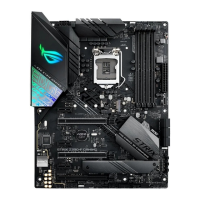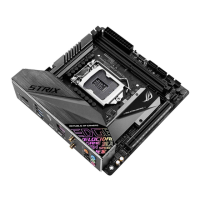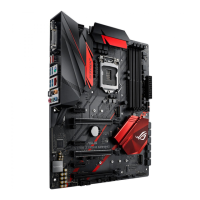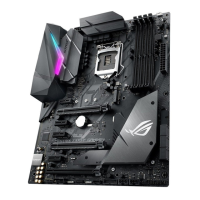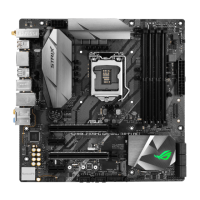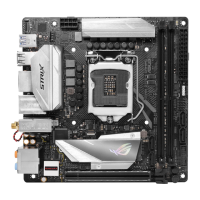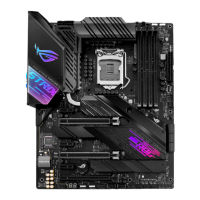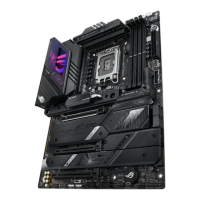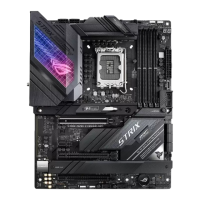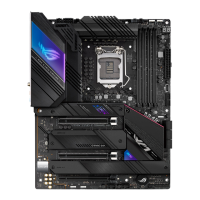Do you have a question about the Asus ROG STRIX Z390-E GAMING and is the answer not in the manual?
Precautions to prevent electrical shock hazards during system handling.
Guidelines for safe operation and handling of the motherboard and components.
Explanation of the manual's structure and chapter breakdown.
Resources for additional product and software update information.
Explanation of symbols used in the manual for safety and guidance.
Guide to text formatting conventions used in the manual.
Precautions before installing motherboard components or changing settings.
Diagram and numbering of motherboard components and connectors.
List of connectors, jumpers, buttons, and slots with corresponding page numbers.
Details on the supported CPU socket and installation guidelines.
Information on DDR4 DIMM slots and recommended memory configurations.
Description and layout of PCIe slots for expansion cards.
Explanation of onboard buttons and switches for system tuning.
Details on the Clear RTC RAM jumper and its function.
Function of the CPU Over Voltage jumper for overclocking.
Description of Q LEDs and Memory LED status indicators.
Overview of various internal connectors on the motherboard.
Guidance on preparing your PC for component installation and system assembly.
Step-by-step instructions for installing the CPU onto the motherboard socket.
Procedure for installing CPU heatsink, fan, or AIO cooler.
Steps for mounting the motherboard securely into the PC chassis.
Instructions for installing and removing RAM modules (DIMMs).
Guide for connecting the main ATX power supply plugs to the motherboard.
Instructions for connecting SATA hard drives and optical drives.
Connecting front panel audio, USB, and other chassis connectors.
Procedure for installing PCIe x16 and PCIe x1 expansion cards.
Steps for installing M.2 SSD modules into the motherboard sockets.
Connecting the dual-band Wi-Fi antenna to the motherboard's Wi-Fi ports.
Procedure for installing the ASUS fan holder and fan assembly.
Overview of rear I/O ports and audio connection configurations.
Diagrams showing how to connect headphones, microphones, and speakers.
Initial power-on sequence, POST checks, and BIOS entry.
Methods for properly shutting down the computer system.
Introduction to UEFI BIOS and its importance for system configuration.
How to enter and navigate the BIOS setup program.
Detailed explanation of the Advanced Mode interface and its features.
Description of the main menu items and navigation within the BIOS.
Using the BIOS search function to locate specific settings.
Controlling RGB LED lighting and functional LEDs through BIOS.
Overview of EZ Mode for basic system information and settings.
Configuring fan profiles and operating speeds for CPU and chassis fans.
Using the AI OC Guide for automatic overclocking setup and guidance.
Wizard for easily setting up RAID configurations in the system.
Personalizing the BIOS by saving and accessing favorite settings.
Overview of basic system information and core settings in the Main menu.
Configuration options for overclocking-related settings.
Changing settings for the CPU and other system devices.
Viewing system temperature, power status, and fan settings.
Configuring system boot options and priorities.
Accessing special function utilities like EZ Flash and Secure Erase.
Updating the motherboard BIOS using a USB flash drive.
Safely cleaning SSDs to restore factory performance levels.
Saving and loading multiple BIOS settings profiles.
Viewing DRAM SPD (Serial Presence Detect) information.
Displaying graphics card information and PCIe slot configuration.
Options for loading defaults, saving, or discarding changes and exiting BIOS.
Instructions and warnings for updating the motherboard BIOS.
Step-by-step guide for updating BIOS via USB or Internet.
Restoring BIOS from corruption using support DVD or USB flash drive.
Overview of supported RAID levels (0, 1, 5, 10) and Intel RST.
Explanation of different RAID levels and their characteristics.
FCC compliance information, RF exposure warning, and regional notices.
Contact details for ASUS technical support and customer service.
Precautions to prevent electrical shock hazards during system handling.
Guidelines for safe operation and handling of the motherboard and components.
Explanation of the manual's structure and chapter breakdown.
Resources for additional product and software update information.
Explanation of symbols used in the manual for safety and guidance.
Guide to text formatting conventions used in the manual.
Precautions before installing motherboard components or changing settings.
Diagram and numbering of motherboard components and connectors.
List of connectors, jumpers, buttons, and slots with corresponding page numbers.
Details on the supported CPU socket and installation guidelines.
Information on DDR4 DIMM slots and recommended memory configurations.
Description and layout of PCIe slots for expansion cards.
Explanation of onboard buttons and switches for system tuning.
Details on the Clear RTC RAM jumper and its function.
Function of the CPU Over Voltage jumper for overclocking.
Description of Q LEDs and Memory LED status indicators.
Overview of various internal connectors on the motherboard.
Guidance on preparing your PC for component installation and system assembly.
Step-by-step instructions for installing the CPU onto the motherboard socket.
Procedure for installing CPU heatsink, fan, or AIO cooler.
Steps for mounting the motherboard securely into the PC chassis.
Instructions for installing and removing RAM modules (DIMMs).
Guide for connecting the main ATX power supply plugs to the motherboard.
Instructions for connecting SATA hard drives and optical drives.
Connecting front panel audio, USB, and other chassis connectors.
Procedure for installing PCIe x16 and PCIe x1 expansion cards.
Steps for installing M.2 SSD modules into the motherboard sockets.
Connecting the dual-band Wi-Fi antenna to the motherboard's Wi-Fi ports.
Procedure for installing the ASUS fan holder and fan assembly.
Overview of rear I/O ports and audio connection configurations.
Diagrams showing how to connect headphones, microphones, and speakers.
Initial power-on sequence, POST checks, and BIOS entry.
Methods for properly shutting down the computer system.
Introduction to UEFI BIOS and its importance for system configuration.
How to enter and navigate the BIOS setup program.
Detailed explanation of the Advanced Mode interface and its features.
Description of the main menu items and navigation within the BIOS.
Using the BIOS search function to locate specific settings.
Controlling RGB LED lighting and functional LEDs through BIOS.
Overview of EZ Mode for basic system information and settings.
Configuring fan profiles and operating speeds for CPU and chassis fans.
Using the AI OC Guide for automatic overclocking setup and guidance.
Wizard for easily setting up RAID configurations in the system.
Personalizing the BIOS by saving and accessing favorite settings.
Overview of basic system information and core settings in the Main menu.
Configuration options for overclocking-related settings.
Changing settings for the CPU and other system devices.
Viewing system temperature, power status, and fan settings.
Configuring system boot options and priorities.
Accessing special function utilities like EZ Flash and Secure Erase.
Updating the motherboard BIOS using a USB flash drive.
Safely cleaning SSDs to restore factory performance levels.
Saving and loading multiple BIOS settings profiles.
Viewing DRAM SPD (Serial Presence Detect) information.
Displaying graphics card information and PCIe slot configuration.
Options for loading defaults, saving, or discarding changes and exiting BIOS.
Instructions and warnings for updating the motherboard BIOS.
Step-by-step guide for updating BIOS via USB or Internet.
Restoring BIOS from corruption using support DVD or USB flash drive.
Overview of supported RAID levels (0, 1, 5, 10) and Intel RST.
Explanation of different RAID levels and their characteristics.
FCC compliance information, RF exposure warning, and regional notices.
Contact details for ASUS technical support and customer service.
| Non-ECC | Yes |
|---|---|
| Memory channels | Dual-channel |
| Memory slots type | DIMM |
| Number of memory slots | 4 |
| Supported memory types | DDR4-SDRAM |
| Maximum internal memory | 64 GB |
| Supported memory clock speeds | 2133, 2400, 2666, 2800, 3000, 3200, 3300, 3333, 3400, 3466, 3600, 3733, 3866, 4000, 4133, 4266 MHz |
| Component for | PC |
| Motherboard chipset | Intel Z390 |
| Audio output channels | 7.1 channels |
| Motherboard form factor | ATX |
| Motherboard chipset family | Intel |
| Windows operating systems supported | Windows 10 |
| BIOS type | UEFI AMI |
| ACPI version | 6.1 |
| BIOS memory size | 16 Mbit |
| Cables included | SATA |
| USB 2.0 connectors | 2 |
| Number of SATA II connectors | 0 |
| Number of SATA III connectors | 6 |
| USB 3.2 Gen 1 (3.1 Gen 1) connectors | 1 |
| PCI Express x1 (Gen 3.x) slots | 3 |
| USB 2.0 ports quantity | USB 2.0 ports have a data transmission speed of 480 Mbps, and are backwards compatible with USB 1.1 ports. You can connect all kinds of peripheral devices to them. |
| LAN controller | Intel® I219-V |
| Wi-Fi standards | 802.11a, Wi-Fi 5 (802.11ac), 802.11b, 802.11g, Wi-Fi 4 (802.11n) |
| Bluetooth version | 5.0 |
| RAID levels | 0, 1, 5, 10 |
| Graphics card | HD Graphics |
| Maximum resolution | 4096 x 2160 pixels |
| Parallel processing technology support | 2-Way SLI, 3-Way CrossFireX |
| Processor socket | LGA 1151 (Socket H4) |
| Compatible processor series | Intel Celeron, Intel Pentium |
| Depth | 244 mm |
|---|---|
| Width | 305 mm |
